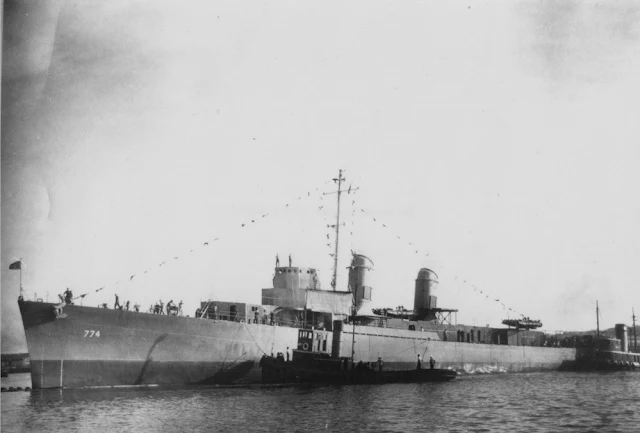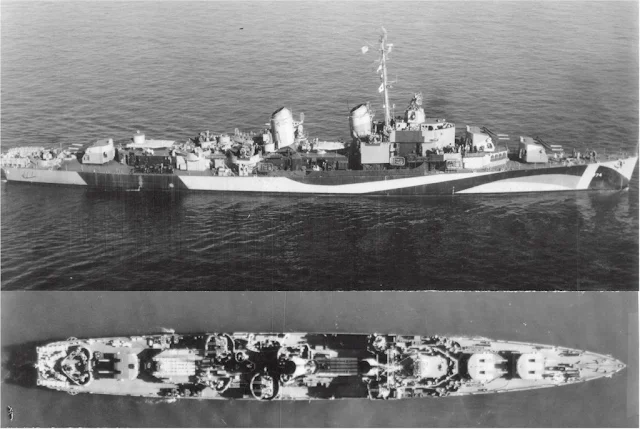USS Hugh W. Hadley (DD-774) was an Allen M. Sumner-class destroyer which served in the United States Navy during World War II. It is the only ship of the United States Navy to be named for Hugh William Hadley, who lost his life during the Naval Battle of Guadalcanal.
Hugh W. Hadley (DD-774) was launched by Bethlehem Steel Shipbuilding Co., San Pedro, California, 16 July 1944; sponsored by Mrs. Hadley, widow of the namesake; and commissioned on 25 November 1944, with Commander L. C. Chamberlin in command.
After intensive shakedown training off the coast of California, Hugh W. Hadley sailed 21 February 1945 in company with HMS Ranee for Pearl Harbor. The ships arrived 27 February, but Hugh W. Hadley was soon underway again, sailing 8 days later for Ulithi and the great Okinawa invasion. The ship departed in company with a large group of LST's and their escorts 25 March bound for the Japanese island stronghold, and arrived off the Okinawa group 31 March. As the night approach was made, Hugh W. Hadley led a group of LST's toward the beach, shooting down an attacking Japanese plane en route. The destroyer escorted her charges safely to the beach, watched them unload their troops and equipment the morning of 1 April, and then took up antisubmarine patrol station outside the transport area. As the bitter fighting ashore continued, Hugh W. Hadley helped protect against submarines and aircraft as the Japanese made a final effort to stop the invasion. The ship remained on patrol until 4 April, when she sailed with a group of transports to Saipan, arriving 14 April.
Hugh W. Hadley was soon on her way back to Okinawa, however, and arrived from Saipan 27 April to resume her outer patrol. For the next few days the destroyer fought off numerous air raids, picked up a downed fighter pilot, and carried out antisubmarine patrol. She went alongside destroyer USS Brown (DD-546) 1 May for transfer of communication equipment, and then took up additional duties as a fighter direction ship for the Combat Air Patrols, so vital to the invasion's air cover.
As radar picket ships were scarce, Hugh W. Hadley was assigned this duty on the afternoon of 10 May. Joining destroyer Evans (DD-552) and four smaller craft, she took station 15 west of Okinawa and early the next morning began vectoring aircraft to meet the oncoming Japanese. For nearly 2 hours the morning of 11 May, Hugh W. Hadley and Evans came under severe attack, as the Japanese mounted their sixth attack against American forces at Okinawa. Both ships maneuvered at high speed, downing many suicide planes and directing air attacks on formations of Japanese. The attackers numbered some 150 planes. After Evans took several serious hits and went dead in the water about 0900, Hugh W. Hadley fought on alone. At 0920, she was attacked by 10 planes simultaneously, from both ahead and astern. The ship destroyed all 10, but not without damage to herself. One bomb hit aft, a Yokosuka MXY-7 Ohka hit, and two kamikaze crashes were inflicted on the ship as her gunners ran low on ammunition. Finally, as the attack ended, all but 50 of the crew were ordered over the side in life rafts, the remaining men fighting fires and working to control the damage. Though her engineering spaces were flooded and she was badly holed, Hugh W. Hadley was kept afloat by the determination and skill of her damage control parties and eventually arrived at Ie Shima. The attack took the lives of 30 crew members.
During this remarkable battle. Hugh W. Hadley had succeeded in downing some 23 enemy aircraft and aided in splashing countless others. After temporary repairs, the ship was taken to Kerama Retto 14 May, where men from repair ship Zaniah worked on her battered hull. Hugh W. Hadley subsequently was taken to Buckner Bay, Okinawa, in a floating drydock towed by Avoyel (ATF-150), 15 July 1945, and after 20 days there began the long voyage under tow of the U.S. Navy tug ATA 199 (still in service on the Great Lakes as the M/T Undaunted) to the United States. After encountering heavy weather during the passage the ship arrived at Hunter's Point, Calif., via Pearl Harbor, 26 September 1945. Decommissioned 15 December 1945, she was sold 2 September 1947 to Walter W. Johnson Co., San Francisco, and scrapped.
In addition to one battle star for her World War II Service, Hugh W. Hadley received the Presidential Unit Citation (U.S.) for her performance in the action off Okinawa 11 May 1945. Also several crew men received fame for their actions during the war.
Namesake: Hugh William Hadley
Builder: Bethlehem Steel, San Pedro
Laid down: 6 February 1944
Launched: 16 July 1944
Commissioned: 25 November 1944
Decommissioned: 15 December 1945
Struck: 8 January 1946
Fate: sold 2 September 1947 scrapped
Class and type: Allen M. Sumner class destroyer
Displacement: 2,200 tons
Length: 376 ft 6 in (114.8 m)
Beam: 40 ft (12.2 m)
Draft: 15 ft 8 in (4.8 m)
Propulsion: 60,000 shp (45 MW);; 2 propellers
Speed: 34 knots (63 km/h)
Range: 6500 nmi. (12,000 km) @ 15 kt
Complement: 336
Armament:
6 × 5 in./38 guns (12 cm)
12 × 40mm AA guns
11 × 20mm AA guns
10 × 21 in. torpedo tubes
6 × depth charge projectors
2 × depth charge tracks
 |
| Undated, location unknown. The ship is painted in camouflage Measure 32, Design 25d. |
 |
| Christening the Hadley is Marian Hadley, widow of Hugh W. Hadley. |
 |
| The Christening ceremony 16 July 1944 at San Pedro with Mrs. Marion E. Hadley breaking the champagne on the bow. |
 |
| The Hadley on the ways during the launching, 16 July 1944, at San Pedro. |
 |
| First time in the water, 16 July 1944, at San Pedro. |
 |
| By invitation only, unless a crew member, for them it was mandatory. |
 |
| The commissioning ceremony, 25 November 1944, at San Pedro. |
 |
| Another view of the commissioning ceremony, 25 November 1944, at San Pedro. |
 |
| USS Hugh W. Hadley commissioning, 25 November 1944, a dress blue affair. |
 |
| L. C. Chamberlain, Captain (Commanding Officer), Sponsor Marian Hadley, and unknown Commodore, probably the Base Commander. |
 |
| December 1944, location unknown. |
 |
| December 1944, location unknown. |
 |
| December 1944, location unknown. |
 |
| San Diego, California, area 23 December 1944 to 20 February 1945 period. |
 |
| Mount 44 firing practice, underway. HMS Ramee (D-03) on horizon. |
 |
| Twin 40mm (not of Hadley) but representative of the two twin mounts on DD-774. Just after the flying bridge abreast of the mast. |
 |
| Mark 37 Main Battery Gun Director. |
 |
| Highline transfer of a sailor from one of the LSTs in the convoy (there were nine LSTs plus an unknown number of escorts) to the Hadley. |
 |
| Highline transfer of LCDR Dwight William Rife, Senior Battalion Medical Officer from one of the LSTs in the convoy to the Hadley. |
 |
| USS Hadley bomb and suicide plane damage, 11 May 1945. |
 |
| Looking aft at portside: nothing is left of the quad 40MM except the geared base ring. The mount crew was KIA. From the LTJG Douglas G. Aitken collection. |
 |
| Damage to the starboard side. From the LTJG Douglas G. Aitken collection. |
 |
| Starboard side of the aft deck house. From the LTJG Douglas G. Aitken collection. |
 |
| Top of the aft deck house. From the LTJG Douglas G. Aitken collection. |
 |
| LCDR Roy Arthur Newton (seen here as a Midshipman), Commanding Officer of the Hadley, 19 June 1945 - September 1945. |
 |
| The Hadley's Scoreboard after operations off Okinawa. |
 |
| The Hadley's commemorative Scoreboard restored by Capt Doug Aiken USN (ret). |
_off_San_Pedro,_California_(USA),_on_11_December_1944_(19-N-75462).jpg)



No comments:
Post a Comment